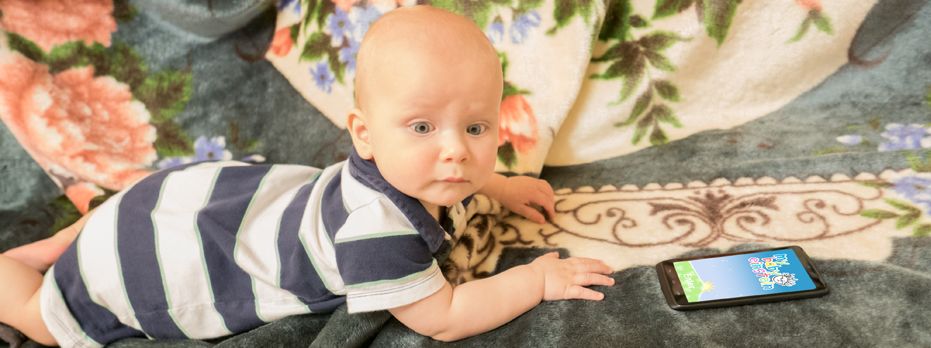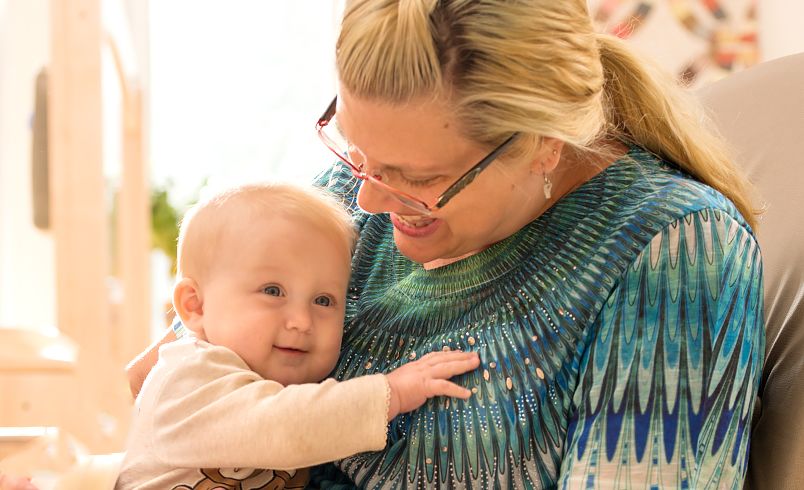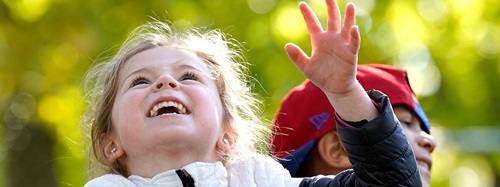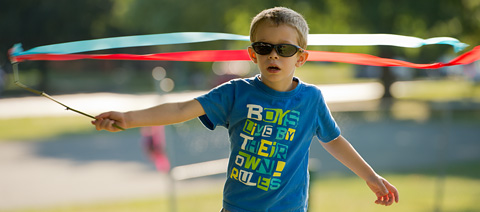Infant/Toddler Learning: Is There an App for That?
| November 2017Infants and toddlers are growing up in a screen-media saturated world. Every day, more and more TV programs, apps, videos, games, and electronic books and toys are being developed and marketed for the care, entertainment, and education of children under age three. And infants and toddlers are surrounded daily by adults modeling the importance of digital devices in their lives.
It is tempting to think that children today are somehow wired differently because of the omnipresence of screen media in their lives. But it’s important to remember that infants and toddlers today learn and grow in the same way that generations before them did. In order to thrive, very young children need responsive interactions with attentive adults, opportunities to play, move, and explore with all their senses, and rich experiences with language—being read to, sung to, and talked with.
It’s not surprising that many teachers (and parents) of very young children have questions and concerns about screen media. There’s no escaping the necessity to become informed about the potential effects of screen media on young children’s learning and development. My colleague, Mary Cornish, and I describe this as being “techwise”. Techwise infant and toddler teachers are knowledgeable about what young children need in order to thrive, and apply that knowledge in their practice to make wise decisions about screen media.
We encourage infant and toddler teachers to consider the following three questions as part of the process of becoming more techwise:
Is Screen Media Use Necessary to Promote Infants’ and Toddlers’ Learning?
There is limited research currently, on the effects of screen media, especially newer media like apps, on infants’ and toddlers’ learning. Though research suggests that there may be some potential for learning, under very specific circumstances, there appears to be more potential for harm.
However, there is a robust evidence base about what infants and toddlers do need in order to learn and thrive. Infants and toddlers are sensory learners who need real-life experiences embedded in meaningful contexts. They learn through responsive relationships with caring adults, verbal and non-verbal exchanges and conversations, physical activity, play, opportunities to actively explore and engage with materials, social interactions with other children, and experiences that allow them to construct knowledge of the world.
Take this example:
Nine-month-old Maria bangs a plastic cup on the table, over and over. From this apparently simple experience Maria is gaining a lot of sensory information: the sense of what it feels like on her hand and arm to bang the cup; the realization that the harder she bangs, the more she feels the sensation; the recognition that a noise accompanies the banging and the noise gets louder when she bangs the cup harder; the feeling of the cup in her hand and how that changes depending on how she grips the cup. Maria soon realizes that she is controlling the strength of the bang and the loudness of the noise and that changing her actions changes the results. But this is not only a physical experience. Through repeatedly banging the cup, Maria is gaining an understanding of cause and effect, which is an important foundational concept in her intellectual development.
On the surface, banging the cup on the table seems like a simple experience. In reality, though, it is a multi-layered learning opportunity that promotes the baby’s physical, social, emotional, and intellectual development. Babies need many, many sensory experiences like this to develop an understanding of cause and effect and a sense of their own capabilities. And the value of this experience is enhanced even further when it occurs within the context of Maria’s relationship with a caring adult. Maria’s teacher can support her learning by providing her with safe materials to handle and explore, observing her interest and allowing her to use the cup in the way she wants, and describing what she notices about Maria’s actions and the noises she is creating.
Think about whether an app or other media product can duplicate this kind of rich sensory experience. While swiping a touch screen to make a picture of a cup appear might support an understanding of cause and effect—I move my finger and a new picture appears—it does not go beyond a very basic level. It offers far less learning than the opportunities Maria had when banging her cup on the table, when she could experience that different types of actions produce different effects.
Can Screen Media Use Interfere With or Negatively Impact Infants’ and Toddlers’ Learning and Development?
The full impact of newer technologies, such as apps and e-books, on infants’ and toddlers’ learning and development is not yet understood. But, decades of research about television and videos have yielded research evidence suggesting that the use of screen media by very young children is associated with higher risks for obesity, attention problems, sleep deprivation, language delays, and aggressive behavior. Even just being exposed to “background television,” or television on in the same room where they are playing, distracts babies’ attention and has negative implications for their language development and social play.
Screen media use can be harmful in situations like these: when it interferes with or prevents children’s social interactions with caring adults; when it keeps the child focused on a two-dimensional screen in the absence of a multi-dimensional sensory experience; when the content is irrelevant, meaningless, or potentially harmful; when the child is a passive recipient of media; when the content is close-ended and focused on right or wrong answers; and when children are spending time in front of screens and not engaged in physical activity or movement.
When thinking about whether or how to use screen media, infant/toddler teachers must carefully consider and avoid the potential negative effects. Given the lack of evidence for any developmental benefit from screen media use by children under two years old, as well as the research suggesting some potential harm, the American Academy of Pediatrics (AAP) strongly discourages screen media use by children under 18 months (with the exception of video chat) and recommends very limited exposure for children from 18 to 24 months.
Screen media should never replace or diminish children’s opportunities to explore, play, experience the world through their senses, interact with other children, and engage and establish relationships with responsive adults.
Can Screen Media be Used to Promote Infants’ and Toddlers’ Learning?
Despite marketing claims that screen media products can set babies on the path to become little Einsteins, the evidence is clear that infants and toddlers are much more likely to learn from real-life, personal interactions than from what they see on a screen. Infants and toddlers have a harder time processing two-dimensional images, like those on a screen, than the three-dimensional images of real life. As noted in the American Academy of Pediatrics 2016 statement on Media and Young Minds, “ Because of their immature symbolic, memory, and attentional skills, infants and toddlers cannot learn from traditional digital media as they do from interactions with caregivers.”
If very young children are exposed to screen media, they should not be left to use it by themselves. Rather, a caring adult should interact with the child during the media encounter, engaging the child in conversation, helping the child make connections to his or her own experiences, and supporting the child’s understanding of the media content. This is called “joint media engagement”. For joint media engagement to be effective, it must go beyond simply watching a TV program or swiping through an app together.
Even in the digital age, infants and toddlers do notneedscreen media in order to thrive. Early childhood teachers can promote infants’ and toddlers’ development and learning without the use of screen media. If media products are used in infant/toddler programs, they should only be used in ways that are developmentally appropriate and conducive to the essential learning goals for children under three. The NAEYC Statement on “Effective Classroom Practice Involving Technology Tools and Interactive Media” (2012) emphasizes this point as well, stating that, for infants and toddlers, “If technology is used, it must be in the context of conversation and interactions with an adult.” According to Chip Donohue, the Director of the Technology in Early Childhood Center at the Erikson Institute and Senior Fellow at the Fred Rogers Center for Early Learning and Children’s Media, technology in the early years is “about relationships.”
When considering if, when, how, and why to use technology with young children we need to look beyond the screens, devices, digital media, and interactive technology to remind ourselves that any choice we make needs to be based on our knowledge of child development and early learning, developmentally appropriate principles, and always in the context of interactions and relationships that support healthy social-emotional development, prosocial behaviors, and create connections between young children and caring adults rather than disconnections. (Donohue, 2014, p. 70)
Infants and toddlers learn in the context of nurturing interactions and relationships with caring adults. There is no app that can substitute for that.
Read the book:http://www.infoagepub.com/products/Techwise-Infant-and-Toddler-Teachers
Works Cited:
AAP Council on Communications and Media. (2016, November). Media and young minds. Pediatrics 138 (5).
Donohue, C. (2014, September). Technology in the early years…it’s about relationships. Child Care Information Exchange, 70-71.
National Association for the Education of Young Children & The Fred Rogers Center for Early Learning and Children’s Media at St. Vincent’s College. (2012). Technology and interactive media as tools in early childhood programs serving children from birth through age 8. Joint Position Statement.Retrieved from http://www.naeyc.org/content/technology-and-young-children








